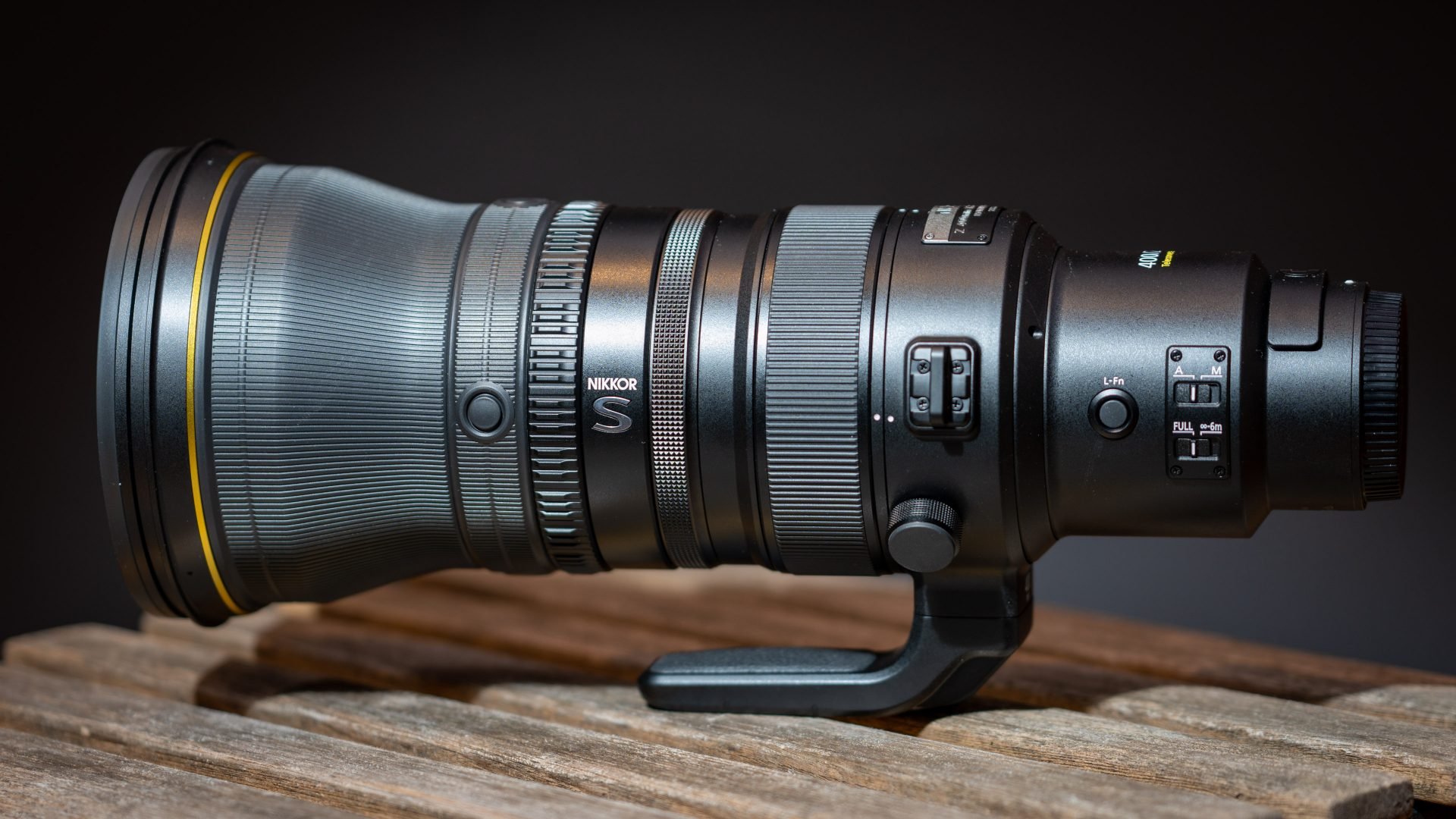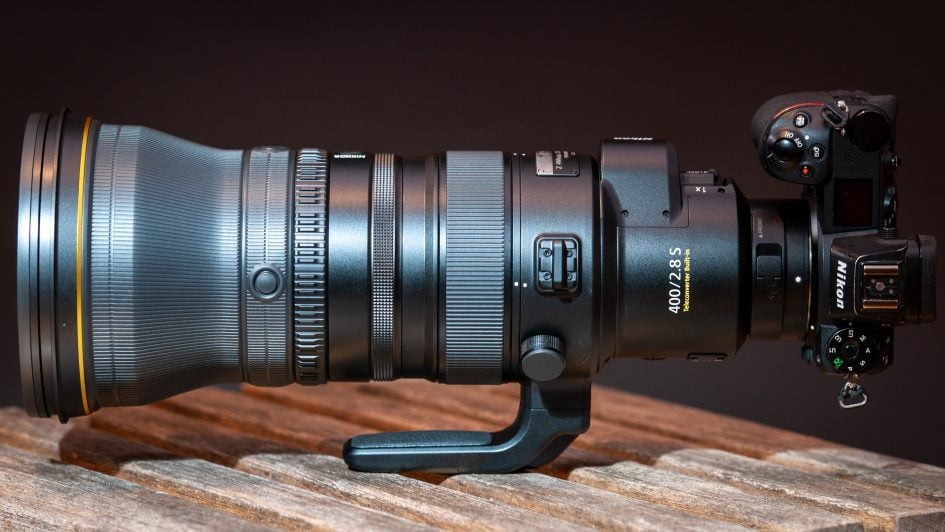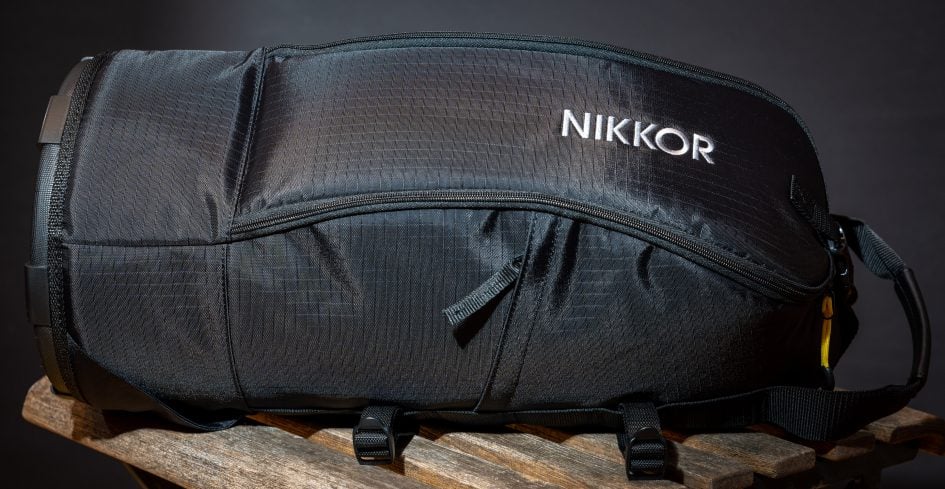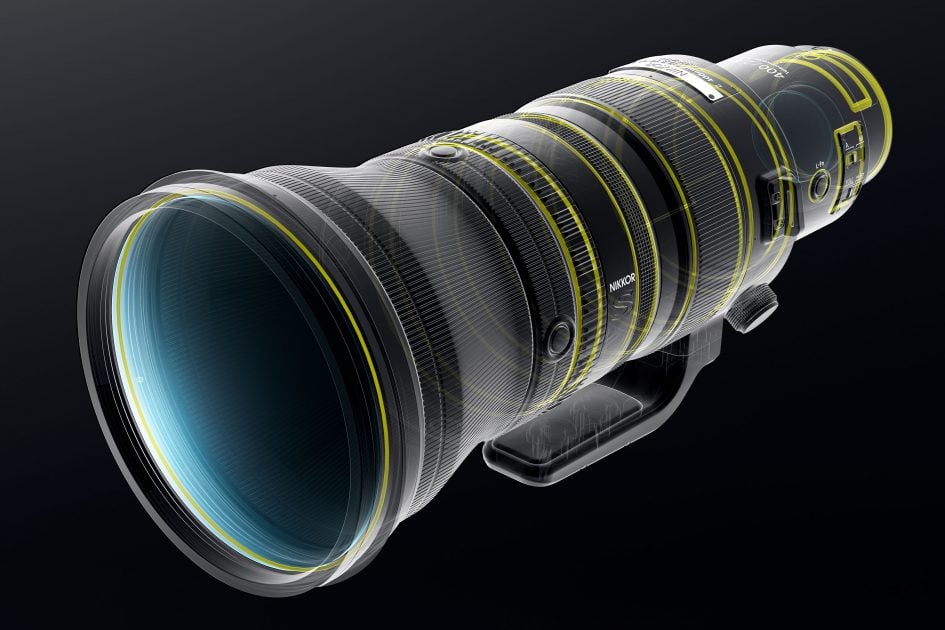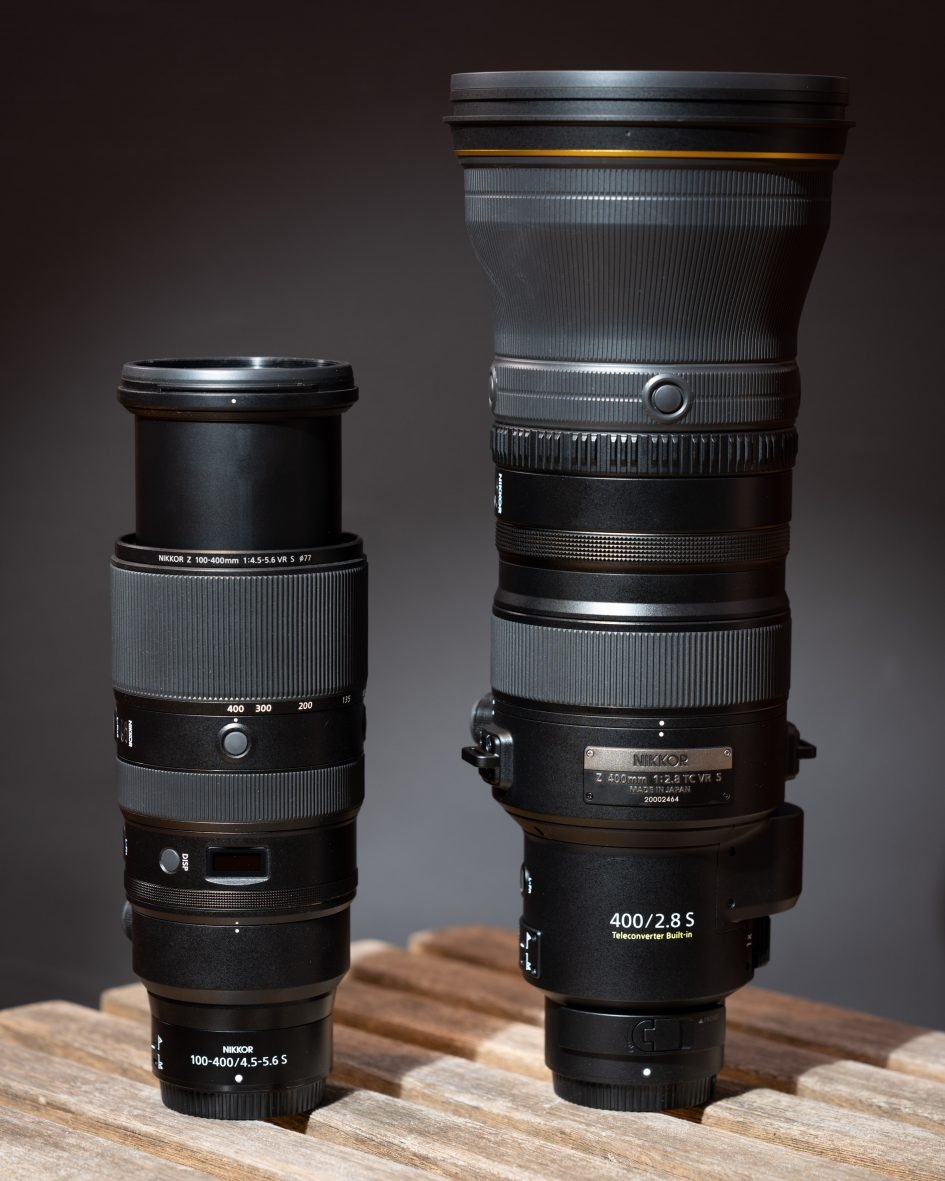Nikon Z 400mm f2.8 TC VR S review
-
-
Written by Thomas
Intro
The Z 400mm f2.8 TC VR S is Nikon’s first long telephoto prime lens for Z-mount aimed at professional sports and wild-life photographers with a large f2.8 focal ratio and a price to match. It is also only Nikon’s second lens after the AF-S 180-400mm 4.0E TC1.4 FL ED VR which has an integrated 1.4x teleconverter (TC). The TC can be activated with a switch and converts the lens into a 560mm f4.0 lens – a feature that neither Sony nor Canon offer for their respective super-telephoto mirrorless primes to date. The new lens is also compatible for use with Nikon’s “external” Z TC-1.4x and TC-2.0x. This allows it to be converted into a 800mm f5.6 or even 1120mm f8.0 lens.
The lens is corrected for full-frame cameras but can also be used on a cropped body like the Z fc or Z50 where it delivers a field of view (depending on the use of TCs) equivalent to 600mm, 840mm, 1200 or 1680mm focal length. Apart from the usual features like optical image stabilization, focus limiter, programmable function buttons, and control ring, the new lens offers other useful features: There’s an integrated filter slot to drop in standard 46mm filters, a memory-set button to save focus distances, and the focus ring can be switched from non-linear to linear response with a choice of different rotation angles (on a Z9). It also offers a new function (Fn) ring to recall the last-saved focus position, plus it’s the first lens to get a new “meso amorphous” anti-reflex coating in addition to ARNEO coating to further increase contrast in challenging contra-light situations. Only the OLED display which has been a hallmark of every high-end Z-Nikkor so far is missing. Nikon also managed to substantially reduce the weight of the lens to just under 3kg from the 3.8kg of its predecessor, the Nikon AF-S 400mm f2.8E FL ED VR which was introduced in 2014 and still can be used via FTZ adapter on Nikon’s Z cameras. So weight-wise Nikon has now caught up with Sony’s and Canon’s 400mm f2.8 lenses for mirrorless bodies – but those lenses don’t carry an integrated teleconverter with them.
The Nikon Z 400mm f2.8 TC VR S is made in Japan and costs 14999 EUR / 13997 USD / 13499 GBP. This seems like an extraordinarily high price but Sony’s and Canon’s own versions are also all in five-figures and come without a built-in TC. If you’re interested in what Sony and Canon have on offer head over to Gordon’s Sony FE 400mm 2.8 GM OSS review so far or Canon RF 400mm 2.8 L RF 600mm f4 L review.
And if the new Z-Nikkor is too big, too expensive, or offers to little reach or flexibility there are four other long lenses on Nikon’s roadmap for the years 2022 and 2023: The just announced Z 800mm f6.3 VR S which should be relatively light due to the use of a Phase-Fresnel (PF) element, a Z 200-600 VR, a Z 600mm f4 VR S, and a Z 400mm f4.5 VR S (focal ratios for the 600mm and 400mm lenses are guestimates).
Facts and features
Let’s compare the Nikon Z 400mm f2.8 TC VR S (“Z 400 TC” for short) to the Nikon AF-S 400mm f2.8E FL ED VR (“F-Nikkor”) and the Nikon Z 100-400mm f4.5-5.6 VR S (“Z 100-400”). I’ve also added some information on Sony’s FE 400mm f2.8 GM OSS and Canon’s RF 400mm f2.8 L IS USM just to give you an idea where the competition stands. As usual I’ve rated the features with a [+] (or [++]), when it’s better than average or even state of the art, a [0] if it’s standard or just average, and [-] if there’s a disadvantage.
Size (diameter x length): 156 x 380mm (6.1 x 15.0in.). The lens hood adds 127mm. The F-Nikkor is 160 x 358 mm + lens hood. Add 30mm for the FTZ adapter to use it on a Nikon Z camera. The Z 100-400 is 98 x 271mm (when zoomed in to 400mm) + 65mm lens hood. Add 19mm resp. 33mm for the TC-1.4x or TC-2.0x. The Sony is 158 x 359mm, the Canon RF is 163 x 367mm. So all modern 400mm f2.8 lenses are more or less the same size. [0]
Weight: 2936g (6.5 lb.) including tripod foot plus 232g for the lens hood. The F-Nikkor is 3800 g + lens hood. Add another 133g for the FTZ adapter to use it on a Nikon Z camera. The Z 100-400 is 1355g + 63g lens hood + 82g tripod foot. Add 220g for the TC-1.4x, 265g for the TC-2.0x. The Sony is 2900g, the Canon RF is 2890g – both without lens hood. Looking at the lens schematics of the Z 400 TC and F-Nikkor below it becomes clear that much of the weight reduction of the new Z 400 TC comes from the slimmer front elements and the movement of the 2nd lens group back towards the camera which also reduces the diameter of that group. This should also move the center of gravity closer to the camera and make the new lens easier to hold. [+]
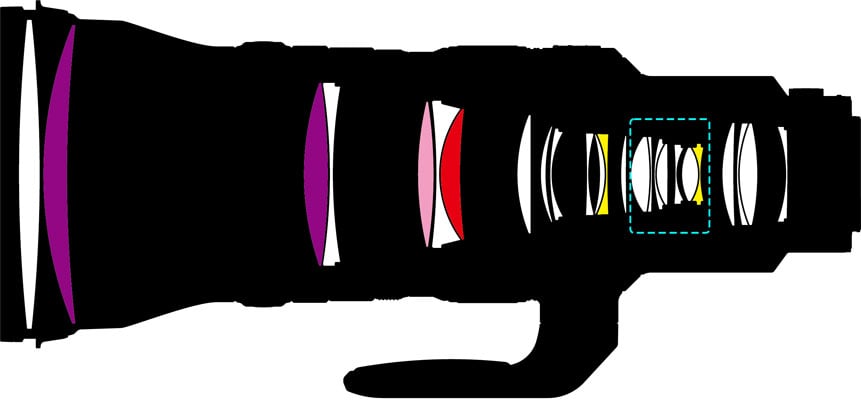
Above: Nikon Z 400mm f2.8 TC VR S; Below: Nikon AF-S 400mm f2.8E FL ED VR
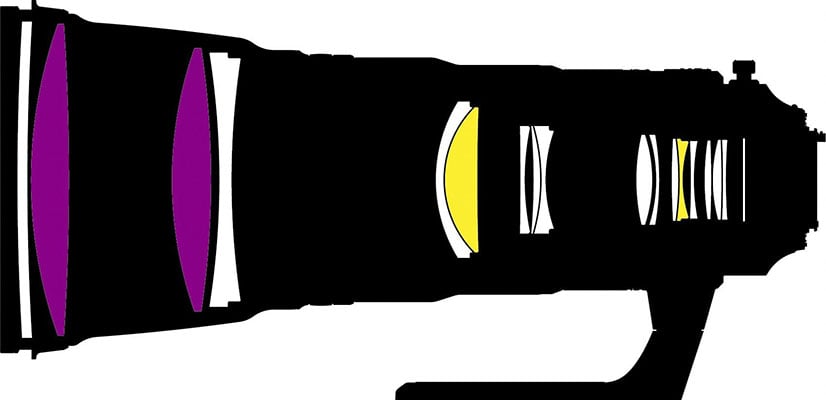
Optics: 18 elements in 15 groups including 3 special dispersion elements and two fluorite lenses but no aspherical element. The built-in 1.4x TC (marked in the image above) adds 7 elements in 4 groups. The lens has a new “meso amorphous” anti-reflective coating in addition to Nikon’s ARNEO-coating to reduce flare, glare and ghosting plus fluorine-coating on the front element to repel water, dust, and dirt and make cleaning easier. The F-Nikkor has 16 elements in 12 groups with two fluorite elements. The Z 100-400 has 25 elements in 20 groups. The TC-1.4x adds 6 elements, the TC-2.0x 8. The Canon RF has 17 elements in 13 groups, the Sony EF 23 elements in 17 groups. [+]
Closest focus distance is 2.41m (7.9ft.) with a working distance of 2.01m (6.6ft.) and a maximum magnification of 1:5.6 which is not much but similar to what the Sony FE and Canon RF offer. A magnification of 1:10 is achieved at 4.1m object distance. Using the built-in TC increases maximum magnification to 1:3.9 without changing the working distance. The F-Nikkor achieves 1:6.3 at 2.2m working distance. The Z 100-400 achieves 1:2.5 at 0.68m working distance at 400mm focal length. [+]
Image stabilization: All three Nikkors offer optical stabilization (VR) which works in conjunction with the body-based stabilization on Nikon’s full-frame Z cameras to achieve a claimed 5.5 stops of stabilization over 5 axes for the Z 400 TC and Z 100-400. For the F-Nikkor the Z cameras only add roll correction to pitch and yaw correction from the lens’s VR. On a Nikon Z9 the Z 400 TC (like the Z 100-400) enjoys an additional benefit from “Synchro-VR”. [+]
Filter-thread: The Z 400 TC has an integrated slot for 46mm standard filters and Nikon offers a slip-in circular polarizing filter as an additional accessory which can be easily rotated (399 EUR). The F-Nikkor has a slot for 40.5mm filters while the Z100-400 uses 77mm standard screw-on filters. [+]
Autofocus: Yes with built-in AF drive. But instead of a stepper motor like all Z-Nikkors so far the new lens uses a voice coil motor (VCM) and optical encoder. The new AF drive technology seems to be the reason for Nikon’s health warning against strong magnetic fields. Manual-focus override is by simply turning the dedicated focus ring at the middle of the lens. On Nikon Z cameras introduced October 2020 or later you can reverse focus direction. The focus ring has the usual variable gearing (like all AF Z-Nikkors so far) which allows for very precise manual focus when turned slowly and can be switched to linear response with a choice of different rotation angles – but only on a Nikon Z9. Focus on the F-Nikkor works differently as it has a direct linear mechanical coupling between the focus ring and the focus action. [+]
Display: No, the Nikon Z 400mm f2.8 TC VR S does not feature an OLED display like the Z 100-400 to indicate focal length, aperture, or focusing distance and depth-of-field. The F-Nikkor sports the usual distance and dof indicators on the focus ring. [0]
Additional functions: There are 4 function buttons at the front (L-Fn2) and an additional L-Fn button behind the focus ring on the lens which can be assigned different functions like AE/AF lock. That is the same as with the Z 100-400. The Z 400 TC is the first lens to offer a function ring in addition to the control ring all Z-Nikkors offer: it works in conjunction with the memory set button near the TC switch to recall saved focus positions by simply turning it a bit to the left or right. To recall a stored focus position simply rotate the Fn ring. All three lenses also sport a focus-limiter which in case of the Z 400 TC prevents the lens to search focus closer than 6m (20ft.). [+]
Aperture ring: The lens has the usual slim multi-function control ring which on the Z 400 TC is located in front of the focus ring. The control ring can be assigned to operate the aperture (which is the default), exposure compensation, or ISO sensitivity – or simply switched off. This is the same as with the Z 100-400 while the F-Nikkor has no dedicated aperture ring. [+]
Lens profile: Both Z-Nikkors and the F-Nikkor come with a lens profile which can be controlled from the camera. Vignette control offers the usual options of High, Normal, Low and Off. Diffraction compensation and Auto distortion control can be activated or deactivated. [+]
All three lenses cover full frame/FX or smaller sensors. [+]
Price: 14999 EUR (incl. 19% VAT) / 13997 USD / 13499 GBP. The Nikon AF-S 400mm f2.8E FL ED VR is 11800 EUR / 11200 USD / 12000 GBP, the Sony FE 400mm f2.8 GM OSS is 11999 EUR / 11998 USD / 10490 GBP, the Canon RF 400mm f2.8 L IS USM is 12999 EUR / 11999 USD / 12449 GBP. Nikon’s Z 100-400mm f4.5-5.6 VR S is 2999 EUR / 2700 USD / 2699 GBP. [0]
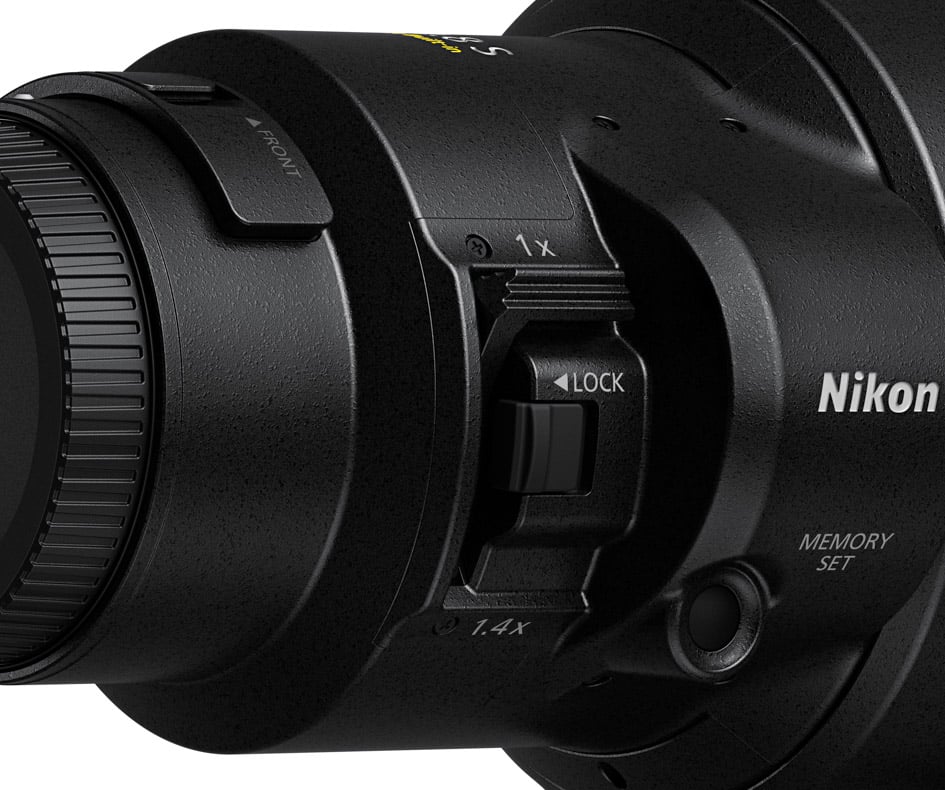
Use with teleconverters: The Z 400 TC has a 1.4x teleconverter already built in which can simply be activated with a switch. The TC switch can be locked and Nikon advises to do so to prevent unintended operation. But the new lens (and the Z 100-400mm f2.8 VR S too) can also be used with Nikon’s teleconverters for Z-mount: The Z TC-1.4x for 549 EUR (incl. 19% VAT) / 547 USD / 549 GBP and Z TC-2.0x for 660 EUR / 597 USD / 580 GBP. Keep in mind though that the Z TCs cannot be used with the FTZ adapter. [++]
Accessories: The Z 400 TC finally comes with a well padded case which offers good protection for lens plus attached camera – a huge improvement over the usual flimsy lens-pouch most other Z-Nikkors come with. It has two straps on the outside to carry a tripod plus a strap inside to secure the lens from inadvertently falling out when you open the case. It also has a grip on top and a shoulder-strap to carry it like a backpack. The lens comes with a plastic lens hood which is locked in place with a screw plus is reversible for transport. It has a rubberized front- and back-end plus it’s coated like black velvet on the inside to reduce reflexes. When you lock the lens hood in place it bends slightly out of shape. Using the lens hood (either normally or in reverse) is the only way to attach the slip-on front lens cover. [+]
Tripod mount: The lens has a tripod collar ring which rotates smoothly – when unlocked. The ring has little play but there are no click-stops at 90 degrees. The tripod foot is firmly attached to the collar with four screws which can be removed with an Allen key. The foot weighs 121g. The whole construction feels very solid once the attachment screw is tightly locked. Under the rubber cap of the screw is a security slot for attaching an anti-theft cable. There are also two eyelets on the tripod collar to attach the included strap to – never use the strap on the camera to carry such a heavy load. Unfortunately Nikon missed out (again) to make the foot Arca-Swiss compatible. The tripod foot has two mounting threads: one 1/4″ and one 3/8″. The latter can be used e. g. for mounting the foot directly on a half ball – which should give you the most rigid connection to a tripod. [0]
Sealing: yes. All three lenses have a rubber grommet at the lens-mount plus further special weather-sealing throughout the construction. [+]
At a score of 0[-]/4[0]/14[+] the Nikon Z 400mm f2.8 TC VR S turns out to be a very well featured lens with its preeminent and unique feature of a built-in 1.4x teleconverter. It also offers a substantially reduced weight over its predecessor and has a new and improved coating to increase contrast in addition to ARNEO anti-reflex coating. It might miss an OLED display and its price is currently higher than the Canon and Sony 400mm f2.8 primes but remember the Nikon has the built-in 1.4x TC, essentially giving you two lenses for the price and weight of one: a 400mm f2.8 and a 560mm f4.
Coverage
With its built-in 1.4x teleconverter and the ability to use Nikon’s Z TC-1.4x and 2.0x teleconverters the Nikon Z 400mm f2.8 TC VR S can cover a 2.8x range of 400mm (f2.8), 560mm (f4.0), 800mm (f5.6), and 1120mm (f8.0) focal length. Here is the angle of view of the different options (Auto distortion control activated) shot from the same viewpoint as in all my reviews:
Above: Nikon Z 400mm f2.8 TC VR S coverage on a full-frame camera at 400mm (left) and 560mm (right)
Above: Nikon Z 400mm f2.8 TC VR S plus Z TC-2.0x coverage on a full-frame camera at 800mm (left) and 1120mm (right)
Focus
Focus accuracy and repeatability is critical to consistently produce sharp shots. Repeatability (the accuracy of focus on the same subject after repeated focus-acquisition) of the Nikon Z 400mm f2.8 TC VR S is very good (measured 99.3% in Reikan FoCal) with no outliers over a series of 40 shots on the well lit and contrasty focus test target. And there is almost no focus variation whether the lens focuses from a closer distance or from infinity. On a Nikon Z7 the lens focuses in around 0.8 sec from infinity to 4.1m (1:10 magnification at 400mm), which is not very fast: The Z 100-400 does the same in 0.6 sec. I wasn’t able to test the Z 400 TC on a Z9 so maybe the lens focuses faster on Nikon’s latest camera body. The lens showed more hunting even on well lit targets than I’m used to see – a consequence possibly of the large circle of confusion from the 143mm wide entrance pupil.
The focus ring is 28mm wide, has a rubberized surface, and moves smoothly. It’s located over the tripod foot. So when using the lens hand-held turn the foot out of the way if you want to use the focus ring.
AF-operation of the lens is practically silent be it in photo-mode or if you record video with the built-in microphone.
As you pull focus, you’ll notice quite some focus breathing: the image became 17% more magnified when I adjusted focus from infinity to 4.1m. This is quite visible when shooting videos.
The lens does not keep its focus well enough when the built-in teleconverter is activated/deactivated. So be sure to refocus after switching the TC.
Image stabilization
To test the effectiveness of the image stabilization with the Nikon Z 400mm f2.8 TC VR S on a Nikon Z7 camera body, I did a series of 160 test-shots hand-held at 400mm focal length with shutter speeds from 1/640 of a second down to 1/10 sec. I used the shots at 1/640 sec with VR=off as reference of how good my hand-holding was at the time of the test and Reikan FoCal did the chore of evaluating the sharpness of all shots.
Here’s the results: With VR=on the combined stabilization from lens and camera produced only 3 outliers in the 100 shots from 1/640 down to 1/40 sec (4 stops) but the rest was clearly better than the average sharpness at 1/640 sec with VR=off. At 1/20 sec (5 stops) results became more erratic but with still only 3 outliers. But at 1/10 sec (6 stops) only one third of the shots were sharp enough. This is a very impressive performance of the combined optical and sensor-based image stabilization supporting Nikon’s claim of 5.5 stops.
I couldn’t test the benefits of “Synchro-VR” because it only works in conjunction with a Z9. Nikon said that Synchro-VR does not improve upon the 5.5 stops of stabilization. I assume that instead the effect of this new function reduces the artefacts that a tilted/moving VR lens group could cause by synchronizing shutter release (resp. sensor read-out) with the movement of the VR group.
Next check out my quality results!
Check prices on the Nikon Z 400mm f2.8 at B&H, Adorama, WEX UK or Calumet.de. Alternatively get yourself a copy of my In Camera book or treat me to a coffee! Thanks!
 Nikon's Z 400mm f2.8 TC VR S is an excellent super-telephoto with one extremely compelling feature over rival systems: It has a built-in 1.4x teleconverter which changes it into a 560mm f4.0 lens at the flick of a switch. This makes the lens much more versatile and a unique "two-for-the-price / weight-of-one" lens for sports and wild-life photography. The lens also produces very sharp images with virtually no field-curvature or colour aberrations and can confidently be used wide open and with the built-in 1.4x teleconverter or Nikon's Z TC-2.0x. Its Bokeh is very nice and the optical image stabilization of over 5 stops proves really helpful with the challenges of hand-holding a 400mm lens. This is also helped by shaving almost 1 kg off the weight of its predecessor, the AF-S 400mm f2.8E FL ED VR. All this makes the Z 400mm f2.8 TC VR S rightfully earn a Highly Recommended - despite its high price.
Nikon's Z 400mm f2.8 TC VR S is an excellent super-telephoto with one extremely compelling feature over rival systems: It has a built-in 1.4x teleconverter which changes it into a 560mm f4.0 lens at the flick of a switch. This makes the lens much more versatile and a unique "two-for-the-price / weight-of-one" lens for sports and wild-life photography. The lens also produces very sharp images with virtually no field-curvature or colour aberrations and can confidently be used wide open and with the built-in 1.4x teleconverter or Nikon's Z TC-2.0x. Its Bokeh is very nice and the optical image stabilization of over 5 stops proves really helpful with the challenges of hand-holding a 400mm lens. This is also helped by shaving almost 1 kg off the weight of its predecessor, the AF-S 400mm f2.8E FL ED VR. All this makes the Z 400mm f2.8 TC VR S rightfully earn a Highly Recommended - despite its high price.